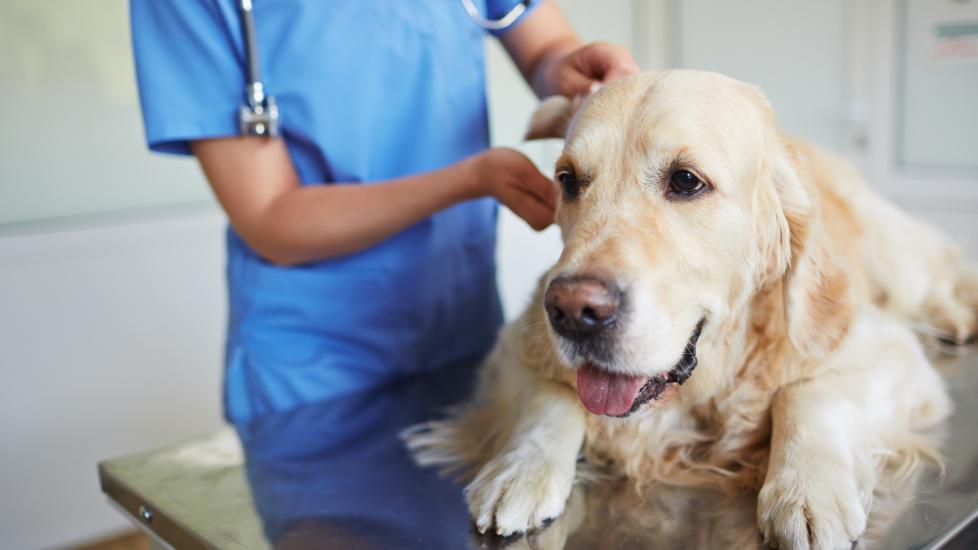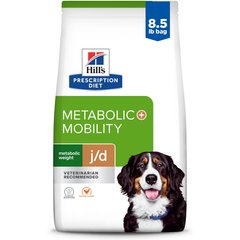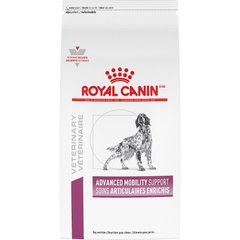Hip Dysplasia Surgery in Dogs
shironosov/iStock / Getty Images Plus via Getty Images
What Is Hip Dysplasia Surgery in Dogs?
Hip dysplasia is a common condition in large breed dogs where abnormal growth or development of the hip joint occurs as a puppy grows.
Normally, the hip’s ball and socket joint fit smoothly together. But in dogs with hip dysplasia, this fit is not as smooth and the joint becomes less stable over time, causing painful arthritis to develop.
Hip dysplasia surgery in dogs is aimed either at younger, growing dogs as a preventable measure or at adult and senior dogs suffering from mobility issues and pain.
Hip dysplasia surgery in dogs is an effective and common procedure that replaces the affected joint with a prosthetic or removes the painful joint altogether.
Types of Hip Dysplasia Surgery in Dogs
There are several surgical options for dogs with hip dysplasia, with some procedures being better suited for certain dogs than others.
-
Juvenile pubic symphysiodesis (JPS). Performed on puppies less than 5 months old as a preventative measure for pups predisposed to developing hip dysplasia or already loose, floppy joints. The growth plate connecting both sides of the pelvis is prematurely sealed, allowing for more rotation to the hips and better alignment as the puppy grows.
-
Triple/Double pelvic osteotomy (TPO). Common in dogs less than 18 months old without evidence of arthritis. The pelvis is cut in multiple places, repositioned, and held together with implants for a better fit.
-
Femoral head ostectomy (FHO). Better suited for smaller dogs, where the femoral head is surgically removed and the joint is allowed to heal, held together by the remaining ligaments and muscles.
-
Total hip replacement. Considered the treatment of choice for dogs suffering from hip dysplasia with arthritis. This procedure allows for re-establishing normal limb function. The acetabulum (hip socket) and femur are drilled out, and a prosthetic ball (inserted into the femur) and socket anchored into the dog’s pelvis.
Anatomy of the Hip in Dogs
The pelvis is a ball-and-socket joint made up of the pelvic socket and the ball or head of the femur (thigh bone). The femoral head is held in place by ligaments and muscles.
In surgery, after an incision is made through the skin and fatty tissue, these ligaments and muscles are dissected so that the surgeon can visualize and access the hip joint.
Why Would a Dog Need Hip Dysplasia Surgery?
Hip dysplasia surgery is the best option for dogs with hip dysplasia, offering a better long-term prognosis and return to function. The surgery may be necessary for dogs due to other reasons as well. These include:
- Dislocated hip
- Fractures involving the pelvis and/or femur
- Severe arthritis in the hip
- Legg-Calvé-Perthes disease (degenerative hip joint condition)
Hip dysplasia surgery in dogs is an effective and common procedure that replaces the affected joint with a prosthetic or removes the painful joint altogether.
Risks of Hip Dysplasia Surgery in Dogs
There are factors to consider before choosing hip dysplasia surgery for your dog, and anesthetic and surgical risks are always important considerations to weigh before proceeding with the procedure. Risks, fortunately, are rare, but may include:
-
Infection
-
Nerve damage
-
Bone fracture(s)
-
Hemorrhage (blood loss)
-
Damage to abdominal organs or other vital structures
-
Thermal injury if electrocautery is used during the surgery
-
Failure of the plate and screws to remain in place
-
Breakage of the implant device
Benefits of Hip Dysplasia Surgery in Dogs
The goal of hip dysplasia surgery in a dog is to provide the dog with a nearly normal, pain-free hip by either preventing or slowing the development of hip dysplasia or treating the painful arthritis already present, and to restore the dog’s hip to normal function.
Without surgery, the loss of mobility and arthritis pain worsen with time and may impact the dog’s quality of life, often significantly.
Effectiveness of Hip Dysplasia Surgery in Dogs
Hip dysplasia surgery can eliminate pain and restore joint function where medications alone may not suffice.
Often paired with a physical rehabilitation program, triple pelvic osteotomy (TPO) surgery offers dogs a high degree of success, with 86–92% achieving normal or near-normal function in operated limbs.
Similarly, femoral head ostectomy (FHO) surgery has shown a 62.8% good to excellent prognosis in dogs.
Total hip replacement surgery can return dogs to normal limb function with a success rate ranging from 80–98%.
For puppies undergoing juvenile pubic symphysiodesis (JPS) surgery, signs of lameness due to joint disease decrease, with approximately 25% of puppies showing no signs of future hip dysplasia and a 74% reversal of hip looseness noted prior to surgery.
Cost of Hip Dysplasia Surgery in Dogs
The cost of hip dysplasia surgery in dogs varies depending on geographic location, the type of surgery performed, and the veterinary clinic. However, you can expect the cost to start at $1,500 and it may reach $10,000 or more.
Hip dysplasia surgery can eliminate pain and restore joint function where medications alone may not suffice.
Many pet insurance plans may cover some or all the cost unless specifically stated in their terms and conditions. Always be sure to review your policy and check with your pet insurance provider. Other options may include applying for CareCredit or utilizing payment plans.
Preparation for Hip Dysplasia Surgery in Dogs
The day before surgery, you will likely be asked not to feed your dog overnight and to arrive at the hospital early in the morning.
After you complete the necessary paperwork, your dog will be hospitalized, have blood drawn, and an IV catheter placed.
The veterinarian will conduct an exam, review paperwork and bloodwork, and then proceed with pre-medication. This includes administering pain medication and sedatives to facilitate anesthesia. An epidural may also be administered as an additional pain management measure.
An endotracheal tube will be placed so that your dog’s breathing can be monitored. The pup will be placed on their side, and then their entire pelvis and leg will be shaved and sterilely prepped.
Complications of Hip Dysplasia Surgery in Dogs
Fortunately, complications are considered minimal and don’t necessarily affect a dog’s quality of life. Such complications may include:
-
Limb shortening
-
Pelvic canal narrowing, which could lead to constipation and difficulty urinating
-
Surgical site infection due to poor post-surgery maintenance
-
Implant(s) loosening
-
Bone fracture(s)
-
Muscle wasting
-
Poor use of the limb
-
Luxation of the hip
Post-Op Care and Recovery for Hip Dysplasia Surgery in Dogs
All dogs undergoing hip dysplasia surgery should have some degree of post-operative exercise restriction, usually for about six weeks, consisting initially of strict confinement followed by slow leash walks, crate rest, and a gradual reintroduction to exercise.
You can expect near-normal levels of mobility around six months after their hip dysplasia surgery.
For many dogs, they will need to bear some weight on the affected hip after their surgery; using a dog support sling or towel placed under the abdomen to assist with walking is helpful.
Avoid stairs, slippery surfaces, and playing with other dogs. Using non-slippery mats, rugs, or products like Dr. Buzby’s ToeGrips® are important to provide your pup with better traction and prevent falls.
Future visits may include additional X-rays of the hip to ensure the bones are healing appropriately and that the implants are stable. Physical rehab can improve your dog’s recovery; speak with your veterinarian about exercises that can be done at home.
Other treatments may include icing the joint several times a day and laser therapy to help decrease pain and swelling, increase mobility, and promote healing. Pain medication, anti-inflammatory medications, and supplements may be prescribed, such as:
- Gabapentin
-
Librela™
-
Dasuquin® or Cosequin®
Future weight management is vital for success. Overweight dogs have a more difficult time during recovery. Weight-loss diets such as Hill®’s Meta-mobility–J/D, or Royal Canin® Advanced Mobility may be prescribed. Consult with your veterinarian about the best supplements and diet for your dog based on their unique needs.
Alternatives to Hip Dysplasia Surgery in Dogs
Hip dysplasia surgery may not be an option for all dogs due to advanced age, inability to undergo anesthesia, or financial constraints of the pet parent.
These cases are often managed conservatively with a combination of:
-
Weight management
-
Modified exercise
-
Pain medications and/or anti-inflammatories (NSAIDs) to reduce arthritis progression and alleviate pain.
Unfortunately, these methods won’t provide the needed stabilization in the hip joint or return the hip joint to normal function.
FAQs:
Is hip dysplasia surgery for dogs worth it?
Surgery is considered the gold standard treatment for dogs diagnosed with hip dysplasia. This is because it offers a better long-term prognosis and return to function, while long-term medical management has limitations in scope of therapy, is not without long-term side effects, and may be just as costly depending on the dog.
References
Dueland R, et al. Canine hip dysplasia treated by juvenile pubic symphisiodesis. Part II: two year clinical results. Veterinary and Comparative Orthopaedics and Traumatology. 2010;23(5), 318–325.
Elefterescu H, et al. The use of sixty degree rotation of the acetabulum for treatment of dogs with canine hip dysplasia. A short case series. Frontiers in Veterinary Science. 2021;8.
Henderson E, et al. Evaluation of variables influencing success and complication rates in canine total hip replacement: results from the British Veterinary Orthopaedic Association Canine Hip Registry (collation of data: 2010–2012). The Veterinary Record. 2017;181(1).
Jahandideh A, Tabary P. Comparison of results of total hip replacement 9THR) with femoral head ostectomy (FHO) in dogs – Review of literatures. Pakistan Journal of Medical and Health Services. 2020;14(3).
Ozdemir G, Bilgili H. Alterations in hip angles following juvenile pubic symphysiodesis in ten dogs with hip dysplasia. The Journal of the Faculty of Veterinary Medicine. 2011;17(3), 393–400.
Punke J, et al. Acetabular ventroversion with double pelvic osteotomy versus triple pelvic osteotomy: A cadaveric study in dogs. Veterinary Surgery. 2011, 1-8.
Sabiza S, Ronagh A, Khajeh A. Effective medical management and physiotherapy program of femoral head and neck ostectomy in 24 dogs and cats; Clinical report. Iranian Journal of Veterinary Surgery. 2019;14(1).
Vezzoni A, et al. Comparison of conservative management and juvenile pubic symphysiodesis in the early treatment of canine hip dysplasia. Veterinary and Comparative Orthopaedics and Traumatology. 2008;21(3), 267–279.





